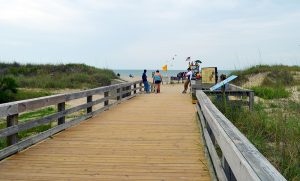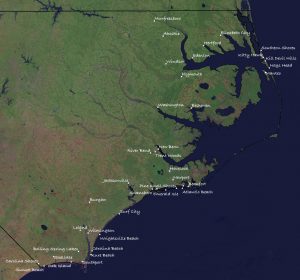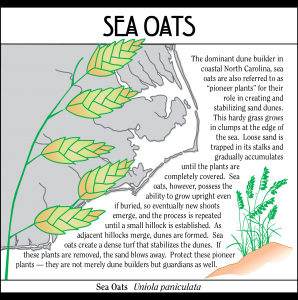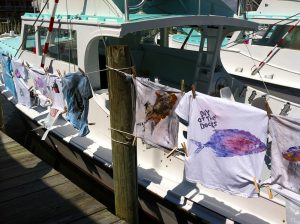By Diana Hackenburg
June 16, 2016
“Let’s go to the coast,” exclaims your mom/dad/uncle/kid/friend as the thermometers rise and social pressures to stay busy fall. The siren sound of North Carolina’s beaches and coastal communities calls loudest during the languid days of summer.

Fort Fisher State Recreation Area. Photo by Diana Hackenburg.
Many will return to an old favorite, a beach or house explored inch by sandy inch throughout the generations. Others will seek out a new, undiscovered-to-them gem on the recommendation of a friend, or more likely nowadays, a travel blog or internet deal.
Wherever you land along the coast this summer, your visit benefits North Carolina’s ocean economy. Tourism is a primary economic driver in our state’s coastal zone, and the money spent there supports the people and places — past and present — that entice us to abandon inland locales and head to the sea.
The ocean economy, as described by Jane Harrison, North Carolina Sea Grant coastal economics specialist, refers to the economic activities that take place in, receive inputs from and provide outputs to the ocean. “Tourism and recreation, seafood, minerals, energy and trade are some sectors of the ocean economy. These activities take place in coastal counties, coastal waters under the state’s jurisdiction and adjacent federal waters,” Harrison explains, summarizing an upcoming report prepared in partnership with Duke University’s Nicholas Institute for Environmental Policy Solutions.

North Carolina’s coast stretches more than 300 miles, with dozens of cities and plenty of natural places to explore along the way. Courtesy NC Sea Grant.
While just a small proportion of the state’s overall economy, the ocean economy contributes significantly to North Carolina’s 20 coastal counties — making up 12 percent of their employment and 6 percent of their total economy. Tourism and recreation activities alone make up some 60 percent of the ocean economy, at a value of $1.1 billion per year, as well as almost 88 percent of jobs in the ocean economy. And that doesn’t even include the figures for recreational fishing.
Tourism and recreation encompass a lot more than digging your toes into the sand and splashing among the waves. From scenic tours to aquarium visits, water ski rentals to fine dining on the waterfront, tourism and recreation benefit businesses big and small in coastal communities. And underpinning all of these activities is a healthy, sustainable natural-resource base.
“The ocean economy depends heavily on natural assets like fish stocks and clean water that can easily be depleted or polluted,” Harrison explains. “If we work to balance economic activity with the long-term health of our coastal ecosystems, we can create a sustainable ocean economy, also known as a blue economy.”
How can tourists help build and support a blue economy? Most existing guides for sustainable travel cater to international adventurers, but many of the principles apply to shorter trips as well.
First and foremost, look after the natural-resource base. Take only photos and memories, leave only footprints. By leaving no trace, you can help keep beaches clean and clear for nesting sea turtles and birds, as well as for rescue crews and future visitors.

Ubiquitous on the North Carolina coast, sea oats help create and stabilize dunes, which buffer communities from storms. Courtesy North Carolina’s Amazing Coast.
Shorelines provide more than just a launching pad for eager swimmers or a scenic overlook. Alive with animals and plants, these unsung ecosystems act as habitat, filter nutrients and pollution from water, stabilize sediment, and protect human development during storms.
Learn more about the coast’s natural wonders by picking up a copy of North Carolina’s Amazing Coast, Sea Grant’s illustrated A-to-Z guide that will also be featured in the upcoming summer 2016 issue of Coastwatch. Or, visit them in person at one of the N.C. Coastal Reserve sites or an N.C. State Park. Also, check out what our friends at the North Carolina Office of State Archaeology’s Underwater Archaeology Branch are doing with their heritage dive trail.
Jack Thigpen, extension director for Sea Grant and avid birder, helps steer development of the North Carolina Birding Trail and recommends the Cedar Point Tideland Trail, in Carteret County near Swansboro. “This 1-mile trail loops through salt marsh and coastal forest, habitat for species like red-headed woodpecker, brown-headed nuthatch, summer tanager and painted bunting, as well as many different wading birds and osprey.”

Look for nesting populations of the painted bunting while traveling along the Cedar Point Tideland Trail in the summer months. Photo by Liani Yirka.
Shopping locally is both fun and smart. Studies show independent retailers keep three times more per dollar spent in the local community than chains. This advice rings especially true for seafood purchases. Buying local seafood promotes commercial fishing, an important part of North Carolina’s rich maritime heritage, and helps ensure you get a high-quality, sustainable product. Check out North Carolina Catch for advice on how to identify fresh, local seafood and where to find it along the coast.
You also can spend locally by planning a new adventure. Hire a local guide, visit a maritime museum or sample the local flavors. Developed with seed funding from Sea Grant, People-First Tourism offers unique North Carolina coastal experiences like woodworking with an Aliwa-Saponi Indian and a boat tour of the Pamlico Sound. Plan ahead and mark your calendar for this year’s Day at the Docks, Sept. 16 and 17 in Hatteras.

The Day at the Docks celebration in Hatteras offers something for everyone: seafood, entertainment, education, competition and community. Photo by Sara Mirabilio.
These suggestions are just a drop in the sea when it comes to exploring North Carolina’s coast in a sustainable manner. Reducing tourism’s footprint will increase the viability and sustainability of coastal communities on many levels: economic, environmental and cultural.
“Working waterfronts, recreation and tourism, and coastal access for all citizens are essential to healthy coastal economies,” notes Susan White, executive director of Sea Grant. “By engaging with communities and industries, we can support a diverse and vibrant economy that also sustains coastal ecosystems and our way of life.”
Now finish packing and head shoreward to discover for yourself North Carolina’s coastal wave of life.
The National Sea Grant network is celebrating 50 years of using research, outreach and education to create and maintain healthy coastal environments and economies. This month, programs will highlight efforts to promote safe and sustainable coastal tourism. Check out North Carolina Sea Grant’s rip currents page for more information on staying safe in the water and the oyster story map for advice on finding and preparing local shellfish.